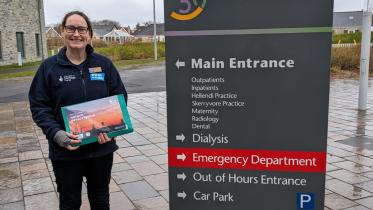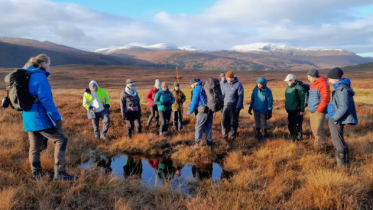
Peatland ACTION and Peatland Code - Frequently Asked Questions (FAQs)

Answers to frequently asked questions from applicants considering peatland restoration
Introduction
Peatland ACTION offers support, guidance and up to 100% funding for all the initial peatland restoration work required to put a site on the road to recovery. There are more details here about what we fund . Peatland ACTION does not provide funding for ongoing management and maintenance of the peatland. If appropriate, landowners and managers can also register their restoration project with the Peatland Code managed by the IUCN UK Peatland Programme (IUCN UK PP), with a view to entering the carbon market in order to receive payments for part of the initial peatland restoration and/or ongoing management. Applications to Peatland ACTION for funding are completely separate from Peatland Code registration, but NatureScot Peatland ACTION are working closely with the IUCN UK PP to try to streamline both processes to bring them in line wherever possible – so that for some parts of the application you can use the same data
Here we try to answer some of the most frequently asked questions about the funding/ finance available, what the two processes currently involve, and where they align, to help landowners and managers decide the best approach for them to take to peatland restoration on their land
What is Peatland ACTION and how do I apply?
Peatland ACTION is the national programme offering funding and support to improve the condition of damaged peatlands across Scotland. It is a partnership led by NatureScot with Forestry & Land Scotland, Scottish Water, Cairngorms National Park Authority and Loch Lomond & the Trossachs National Park Authority.
Peatland ACTION funding comes from the Scottish Government and primarily supports on-the-ground peatland restoration activities and is open for applications from eligible landowners and managers who have peatlands that would benefit from restoration. There are no geographical restrictions or target areas for Peatland ACTION funding.
The first step to applying for funding and support is to email Peatland ACTION at [email protected].
What is the IUCN Peatland Code and how do I register?
Peatland code is a UK government-backed, domestic voluntary carbon market standard. Landowners with eligible damaged peat can follow the standard to attract private finance for peatland restoration by selling carbon units.
To register a project you can open a free account on the Environmental Registry. You can choose to employ a project developer to oversee the restoration process, in which case they register a project for you.
What will Peatland ACTION fund? And what support can Peatland ACTION provide?
Funding and/or support from Peatland ACTION can include:
- Feasibility studies
- Peat depth surveys
- Species surveys
- Hydrological surveys
- Project design – including support with Permitted Development Rights, construction design and management regulations and other consents
- Guidance and support with the tendering process
- Help with the application
- Full cost of practical works
- Project management
We do not fund agents’ fees for the preparation of the application, or costs related to the registration, validation or verification process for Peatland Code.
If I decide to register for Peatland Code when is the best time to start the process?
The project cannot have already begun restoration before it is registered. After registering, your project plan validation must be achieved within 3 years. It is advisable to register as early as possible as the process is free, and the start dates and data are allowed change between registration and validation.
Is the process the same for both Peatland ACTION and Peatland Code?
The processes are different but elements of the Peatland ACTION process will be very useful to your Peatland Code validation, such as the feasibility study and restoration plan design. Parts of the application processes can happen at the same time.
What information is needed for a Peatland ACTION application?
You must get in touch with Peatland ACTION as early as possible when considering submitting an application. We’ll arrange for one of our Project Officers to support you to develop your project and advise on specific application requirements.
Information needed for the application will include, or support the preparation of:
- Prior Notification Permitted Development Rights
- Construction (Design & Management) Regulations 2015
- Peat Depth & Condition Survey
- Spatial data
- Depending on the site, species surveys, archaeological surveys, utilities searches etc may also be needed.
What information is needed to register for Peatland Code?
You need to upload a draft map (which includes the project name and grid reference) and a draft emissions calculator (using the latest template from our website). The initial condition of the peatland, peat depth and hectares are needed to complete registration.
Is there a minimum hectarage for applying for Peatland ACTION funding?
Generally, projects are expected to be greater than 10 ha with a cost over £10,000.
Is there a minimum hectarage for registering for the Peatland Code?
No, although the project costs, levy fees and validation/verification fees mean that a smaller project may not be financially viable.
Is there a minimum peat depth for applying for Peatland ACTION funding?
The majority of the peatland within a project area must have a peat depth of over 50cm, but peat depths down to 30cm will be considered for restoration if they form an intrinsic component of the peatland hydrological unit.
Is there a minimum peat depth for registering for the Peatland Code?
The minimum average peat depth must be above 30cm.
Are there any costs associated with applying for Peatland ACTION funding?
No, it is free to apply for Peatland ACTION funding, unless you employ an agent to prepare the application on your behalf.
Are there any costs associated with registering for the Peatland Code?
No, it is free to open an account and register a project. There is a 5p per unit levy fee once PIUs/PCUs are released.
If I receive Peatland ACTION funding how long is the commitment to maintain the restoration after completion?
The landowner is committed to maintain the restoration process for 10 years after restoration work is completed.
If I successfully validate the restoration work with the Peatland Code how long is the commitment to maintain the restoration after completion?
The landowner and project developer are committed to maintain and monitor the restoration for the duration of the project. Project lengths vary from 30-100 years.
Why should I register for the Peatland Code?
By using the Peatland Code, a landowner can receive private financial investment through the sale of carbon units (carbon finance). The high integrity of the code provides assurances to buyers. There are two unit types available to purchase:
- A Pending Issuance Unit (PIU) is effectively a ‘promise to deliver’ a Peatland Carbon Unit in the future. It is not ‘guaranteed’ and therefore cannot be used to report against emissions until verified. However, it allows companies to plan to compensate for future emissions
- A Peatland Carbon Unit (PCU) is a verified PIU. It is a tonne of CO2 e emissions savings from a Peatland Code certified peatland. It has been independently verified, is guaranteed to have been achieved, and can be used to report against a business’s emissions as soon as it is purchased.
What happens after registering a project for the Peatland Code?
- The project undergoes a two-step validation; Project Plan Validation, which might take anywhere between 3-12 months. A suite of documents and evidence are reviewed desk based by an independent validation body and upon validation the landowner can choose to issue PIUs if they wish.
- Step 2 is Restoration Validation, which must take place within a year of restoration is completed and involves an assessor site visit. PIUs are issued upon successful restoration validation if they were not already at Project Plan Validation.
- Verification will take place at year 5 of the project “Start date” and thereafter at least every 10 years.
Does a Peatland Code project have to be validated before restoration begins?
Ideally, project plan validation should be in place before any restoration work starts. If needed however, restoration could start prior to completion of project plan validation IF sufficient baseline evidence is handed in to the validation body.




